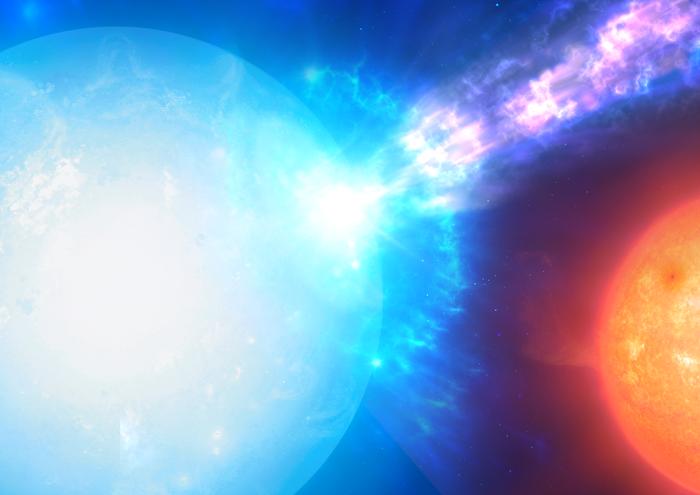A micronova is a thermonuclear blast that lasts for just a few hours making them extremely difficult to observe.
These outbursts happen on the surface of certain stars and can each rapidly burn through a huge amount of stellar material equivalent to around 3.5 billion Great Pyramids of Giza.
An international team of researchers, led by Durham University, UK, saw the phenomenon in three white dwarfs – the remnants of dead stars – as they fed in each case on a companion star.
They say their discovery could lead to more micronovae being found and challenge what we know about how thermonuclear explosions occur in stars.
The research is published in the journal Nature.
The team first came across the unusual micronovae when they noticed a bright flash of light lasting for a short time while analysing data from NASA’s Transiting Exoplanet Survey Satellite (TESS).
In total they have since observed three micronovae using TESS – normally used to look for planets outside of our solar system.
Two micronovae were from already known white dwarfs, but the third needed more observations with the X-Shooter instrument on the European Southern Observatory’s (ESO) Very Large Telescope (VLT) for its white dwarf status to be confirmed.
Lead author Dr Simone Scaringi, in the Centre for Extragalactic Astronomy, Durham University, said: “We have discovered and identified for the first time what we are calling a micronova
“The phenomenon challenges our understanding of how thermonuclear explosions in stars occur. We thought we knew this, but this discovery proposes a totally new way to achieve them.
“It just goes to show how dynamic the Universe is. These events may actually be quite common, but because they are so fast they are difficult to catch in action.”
Micronovae are extremely powerful, but are small on astronomical scales compared to novae and supernovae, which are extremely bright and have been known about for centuries. There are numerous accounts across history of “new stars” being seen by astronomers which we now call novae.
In novae this thermonuclear explosion occurs over the entire surface of the star and the intensely bright light from this blast can be seen for weeks. Some supernova, on the other hand, are so energetic they burn the entire white dwarf.
Both types of explosions occur on white dwarfs, dead stars with a mass similar to that of our Sun, but as small as the Earth in size.
White dwarfs can steal material, mostly hydrogen, from their companion stars if they are close enough to them.
As the hydrogen falls on to the very hot surface of the dwarf star its atoms fuse into helium in explosive fashion.
In novae this thermonuclear explosion occurs over the entire surface of the star and the intensely bright light from this blast can be seen for weeks.
Micronovae are similar explosions that are smaller in scale and faster, lasting several hours.
The researchers say that they occur on some white dwarfs with strong magnetic fields, which funnel material towards the star’s magnetic poles.
Study co-author Professor Paul Groot, of Radboud University, the Netherlands, said: “For the first time, we have now seen that hydrogen fusion can also happen in a localised way.
“The hydrogen fuel can be contained at the base of the magnetic poles of some white dwarfs, so that fusion only happens at these magnetic poles.
“This leads to micro-fusion-bombs going off, which have the strength of about one millionth of a nova explosion, hence the name ‘micronova’.”
The team now wants to capture more of these elusive events, which will require large-scale surveys and quick follow-up measurements.
Dr Scaringi added: “Rapid response from telescopes such as the VLT or ESO’s New Technology Telescope and the suite of available instruments will allow us to truly unravel what these mysterious micronovae are.”
The research was funded in the UK by the Science and Technology Facilities Council.
A follow-up paper, where the research team propose a model showing that magnetic confinement of material on to an accreting white dwarf could trigger localised thermonuclear bursts is also due for publication in the journal Monthly Notices of the Royal Astronomical Society.
ENDS
About Durham University
Durham University is a globally outstanding centre of teaching and research based in historic Durham City in the UK.
We are a collegiate university committed to inspiring our people to do outstanding things at Durham and in the world.
We conduct boundary-breaking research that improves lives globally and we are ranked as a world top 100 university with an international reputation in research and education (QS World University Rankings 2022).
We are a member of the Russell Group of leading research-intensive UK universities and we are consistently ranked as a top 10 university in national league tables (Times and Sunday Times Good University Guide, Guardian University Guide and The Complete University Guide).
For more information about Durham University visit: www.durham.ac.uk/about/


